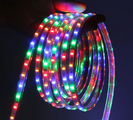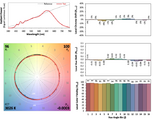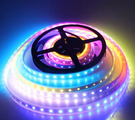Do LED strip lights have positive and negative poles? How to fix LED strip lights?
Do LED lights have positive and negative poles?
LED lights have positive and negative poles.
The method of distinguishing the positive and negative poles of three-wire LED strips is as follows:
1. Use a digital multimeter, select the diode setting, and touch the black and red test leads to both ends of the LED. When the LED lights up, the red test lead touches the positive electrode and the other end is the negative electrode. To the naked eye, there are two poles, the extremely narrow one is the positive pole, and the wide one is the negative pole. Generally, the negative electrode side is flat when touched by hand, and the positive electrode side is arced.
2. If you buy a new LED, the legs have not been cut off. The long leg is the positive pole.
3. Generally, novices of LED strip lights will look at the missing corners. One side of the missing corners is the negative electrode, and the other side is the positive electrode.
4. Use the diode or resistor setting of the multimeter. If it lights up, the red test lead is connected to the positive electrode of the LED.
5. Connect a 1.5V battery to the LED. If it lights up, the battery is connected to the positive pole of the LED.
6. Look at the color. The red arrow points to the negative electrode. Generally, the larger part is the negative electrode. For example, in batteries, the negative electrode is over a large area, and the positive electrode is just a point; in automotive appliances, the negative electrode is installed on the car body, and the positive electrode goes to different places. So the big place is the negative pole.
7. If it is a lantern, the three colors are the same pole, usually the positive pole. It is a very simple way to distinguish them by seeing if there is a black wire as the ground wire.

How to fix LED strip lights
1: First determine the length to be installed, and then take an integer to cut it off. Because this kind of light strip has a unit of 1 meter, it will not affect the circuit until it is cut off from the notch. If it is cut at will, it will cause one unit to not light up. For example: If a length of 7.5 meters is needed, the light strip needs to be cut to 8 meters. Example: If a length of 7.5 meters is needed, the light strip needs to be cut to 8 meters. 2: Link plug LED itself is a diode, driven by DC, so it has positive and negative poles. If the positive and negative poles are connected reversely, they will be in an insulated state and the light strip will not light up. If the connecting plug does not light up when powered on, you only need to disconnect the other end of the light strip.
2: Placement of strip lights The strip lights are packaged in trays. The newly disassembled strip lights will be twisted and difficult to install. You can straighten them first and then put them into the light trough. Since the light strip emits light from one side, uneven light and dark will appear if it is placed unevenly. Pay special attention to corners.
3: Placement of strip lights The strip lights are packaged in trays. The newly disassembled strip lights will be twisted and difficult to install. You can straighten them first and then put them into the light trough. Since the light strip emits light from one side, uneven light and dark will appear if it is placed unevenly. Pay special attention to corners.





